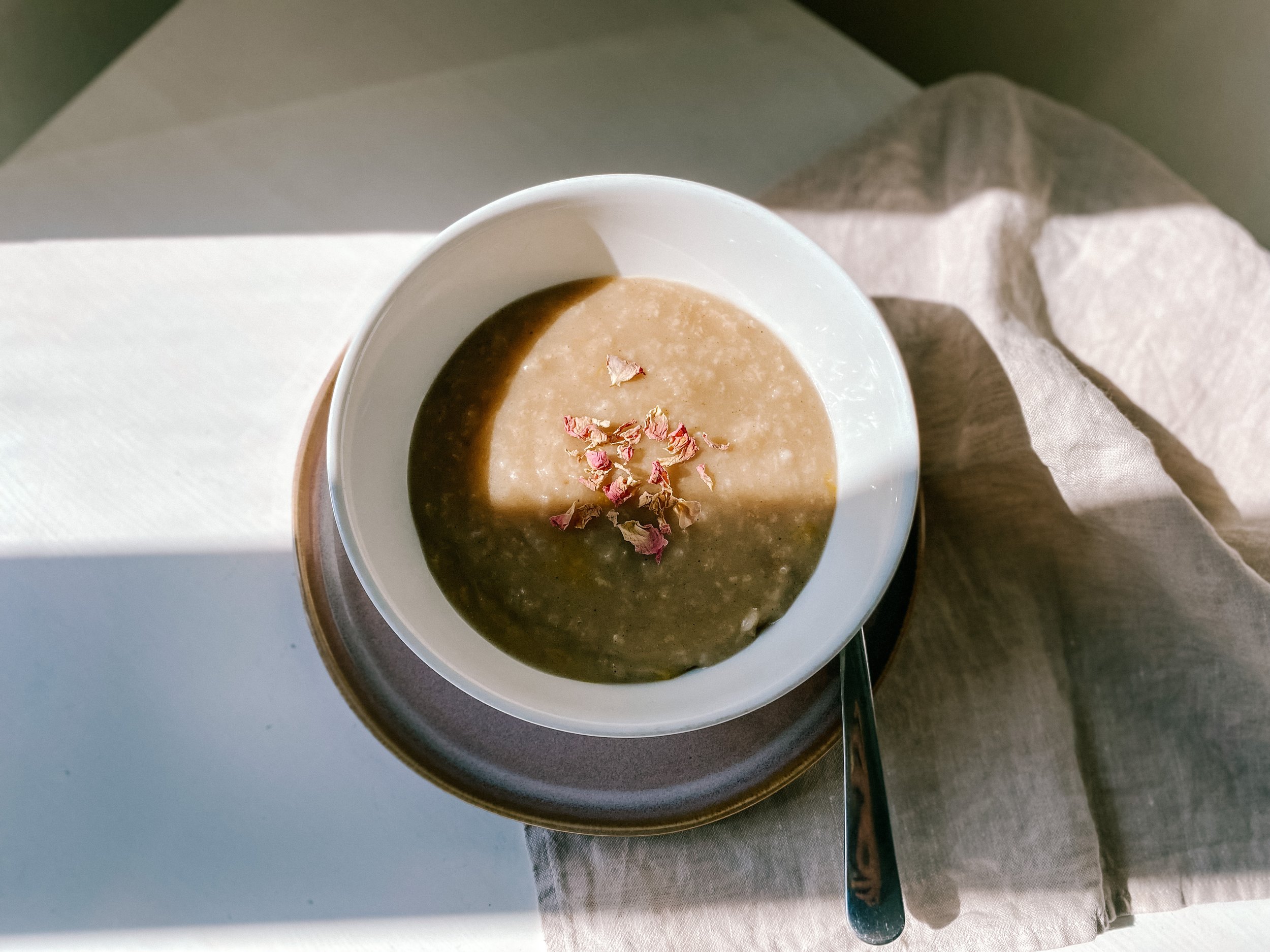First Day’s Rice Porridge
After birth, you will need accessible energy in the form of food that contains blood sugar-stabilizing fats, and certain warming spices to help digest it. This rice porridge contains all of that and much more.
Labor can be depleting, especially bodily fluids. After the first step of digestion, liquids would nourish plasma (rasa dhatu), and then blood (rakta dhatu) tissues. If the first two are depleted, so will all other five tissue layers, as well as your immunity, and glow (ojas).
This dish is quite moist, it will fully nourish you and will help rebuild healthy iron levels, especially rasa and rakta dhatu, making way, to feed all other dhatus (tissues).
Rock salt is the only salt you should want to use after birth, as it does not lead to fluid retention, which can occur after giving birth. But still, it would be best to keep your salt intake less than your usual amount.
This meal is called pasayam in Nepal and kanji in other places, and often entirely cooked without salt. While in Nepal it would be fermented, this is not. You could eat this meal by itself for five days straight, as breakfast, lunch, and dinner.
Rice porridge with good spices and ghee will steadily rekindle your digestive fire, and nourish you deeply, from the inside out.
All the mothers that I have served this right after birth absolutely loved it. They said it was the most perfect meal they could have wished for. Although some were critical before, they were beyond grateful for this “belly hug”.
You could make this for your partner and keep it in a thermos, in case of a hospital birth or if she wants to give birth at a local birth center.
Generally, you should set this up when the first regular contractions are starting to make its way. This meal will cook slowly on the stove while the labor process continues. A birth doula would start cooking it on low heat and then serve it completely fresh to the newborn mother, after her strenuous work.
Once, I made a similar version within 15 minutes with oats, soaked and peeled almonds, saffron, and dates before a hospital birth, and took it with me in a thermos. The mother absolutely loved it. Even if you have hospital meals, they might arrive super late, and even the best private hospitals do not serve according to the digestive fire of a new mother’s needs. PS. Make sure to bring a spoon with you.
This recipe is as versatile, as it gets, just play around. But always keep the mother’s low digestive fire in mind. Especially in the beginning, it would be best to use the recipe as it is written here.
There are many many versions of this meal. This recipe is how my clients, and myself like it most. However, people in very hot climates and with fiery, heated pitta prakruti may need a little less ghee, and more cooling spices, such as cardamom, and less heating spices.
If the mother has a lot of kapha dosha in her constitution, or toxic, white residue on her tongue (ama), please use only 1 tbsp of ghee. If the mother is vegan, you should still tell her about the benefits of ghee, as seen here. In short, ghee is a brain tonic, and it is the only fat that is thermically neutral, meaning it serves all prakriti (body-mind types). It also is the only healthy fat, that gently stokes the digestive fire (jatharagni). However, if she still wants to consume only vegan meals, you could try making this with organic, cold-pressed sesame oil, but it will not have the same benefits, be much heavier, and may taste different, as you can imagine. Ghee can’t be substituted. This is why it is used medicinally for thousands of years in ancient Ayurvedic, herbalized formulas.
This meal can be eaten from day one. It serves 4-8 portions (depending on your portion size). You should make it fresh, from scratch, and don’t be tempted to consume leftovers. Originally, it would take 2-6 hours to cook. But if you are low on time, you could turn the heat up and cook it much faster.
INGREDIENTS
- 16 cups (3,4 l) water
- 1 cup (200 g) basmati rice
- 8 tbsp ghee
- 5 tbsp whole raw cane sugar
- 1 tsp cinnamon
- 1/2 tsp ground turmeric
- 1/8 tsp pippali (long pepper or black pepper)
- 1/8 tsp ground clove
- a few saffron threads
- pinch of rock salt
- squeeze of lemon
METHOD
Soak the rice overnight. If you forgot, don't worry, rinse it until the water becomes clear.
Put the ghee in the pot and add the spices (besides the salt and pepper).
Let the aroma arise, then you can add rice and water.
Cook for at least 2 until 6 hours on medium-low heat.
In the end, you can add a pinch of salt, pepper, and a squeeze of lemon.
If you want your whole family to eat this meal, use less ghee and then put more ghee right on top of the porridge into her bowl. Like this, everyone can enjoy it!
